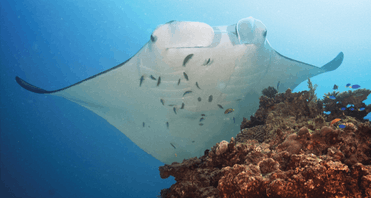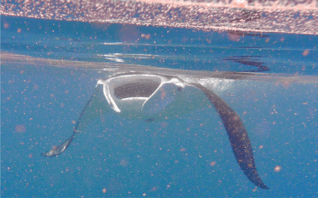Reef manta ray
| Reef manta ray | |
|---|---|
| | |
| M. alfredi in the Maldives | |
| Scientific classification | |
| Kingdom: | Animalia |
| Phylum: | Chordata |
| Class: | Chondrichthyes |
| Subclass: | Elasmobranchii |
| Order: | Myliobatiformes |
| Family: | Myliobatidae |
| Genus: | Manta |
| Species: | M. alfredi |
| Binomial name | |
| Manta alfredi (J. L. G. Krefft, 1868) | |
The reef manta ray (Manta alfredi)[2] is a species of ray in the family Mobulidae, one of the largest rays in the world. Among generally recognized species, it is the second-largest species of ray, only surpassed by the giant oceanic manta ray (a currently unrecognized species from the Caribbean region also appears to be larger than the reef manta ray).[3] Its scientific name is a tribute to the British Prince Alfred, Duke of Saxe-Coburg and Gotha, who was victim of an assassination attempt in Clondarf in Australia at the time the description of the species was published by the director of the Australian Museum Gerard Krefft in 1868.[4]
Reef manta rays are typically 3 to 3.5 m (9.8 to 11.5 ft) in disc width,[2] with a maximum size of about 5.5 m (18 ft).[3] Long included in M. birostris, the status of the reef manta ray as a separate species was only confirmed in 2009.[3] The reef manta ray is found widely in the tropical and subtropical Indo-Pacific, but with a few records from the tropical East Atlantic and none from the West Atlantic or East Pacific.[3][5] Compared to the giant oceanic manta ray, the reef manta ray tends to be found in shallower, more coastal habitats,[3][5] but local migrations are sometimes reported.[6] Manta birostris is similar in appearance to Manta alfredi and the two species may be confused as their distribution overlaps. However, there are distinguishing features.
Description
The reef manta ray can grow to a disc size of up to 5 m (16 ft) but average size commonly observed is 3 to 3.5 m (11 ft).[7][8] It is dorsoventrally flattened and has large, triangular pectoral fins on either side of the disc. At the front, it has a pair of cephalic fins which are forward extensions of the pectoral fins. These can be rolled up in a spiral for swimming or can be flared out to channel water into the large, forward-pointing, rectangular mouth when the animal is feeding. The eyes and the spiracles are on the side of the head behind the cephalic fins, and the 5 gill slits are on the ventral (under) surface. It has a small dorsal fin and the tail is long and whip-like. The manta ray does not have a spiny tail as do the closely related devil rays (Mobula spp.).[9] The color of the dorsal side is dark black to midnight blue with scattered whitish and greyish areas on top head. The ventral surface is white, sometimes with dark spots and blotches. The markings can often be used to recognise individual fish.[10] Manta alfredi is similar in appearance to Manta birostris and the two species may be confused as their distribution overlaps. However, there are distinguishing features.
Physical distinctions between oceanic manta ray and reef manta ray
The first difference could be the size because the oceanic manta ray is bigger than the reef manta ray, 4 to 5 meters in average versus 3 to 3,5 meters.[7] However, if the observed rays are young, their size can easily bring confusion. Only the color pattern remains a fast and effective way to distinguish them. The reef manta ray has a dark dorsal side with usually two lighter areas on top of the head, looking like a nuanced gradient of its dark dominating back coloration and whitish to greyish, the longitudinal separation between these two lighter areas forms a kind of “Y”. While for the oceanic manta ray, the dorsal surface is deep dark and the two white areas are well marked without gradient effect. The line of separation between these two white areas form meanwhile a "T".
Difference can also been made by their ventral coloration, the reef manta ray has a white belly with often spots between the branchial gill slits and other spots spread across trailing edge of pectoral fins and abdominal region. The oceanic manta ray has also a white ventral coloration with spots clustered around lower region of its abdomen. Its cephalic fins, inside of its mouth and its gill slits are often black.
Distribution & habitat
The reef manta ray has a widespread distribution in tropical and subtropical waters worldwide. It can be observed in some well-known spots like for example in the eastern Ocean Pacific (Hawaii, French Polynesia) and in the Indo-Pacific (Fidji, Indonesia(Bali & Komodo), Maldives, Mozambique, Australia, Micronesia, Philippines...).[11]
Reef manta rays live in a more or less identical wide area with the possibility of short migration to follow the zooplankton. They therefore have a relatively sedentary behavior with precise areas for cleaning and feeding still within close proximity of coasts, reefs or islands.[12]
Biology
The reef manta ray has a pelagic lifestyle and feeds by filtering sea water in order to catch his favorite food that represents zooplankton. Research would indicate that mantas probably live to at least 50 years old.[7]
The reef manta ray, as the oceanic manta ray, is ovoviviparous. After mating, the fertilized eggs develop within the female's oviduct. At first, they are enclosed in an egg case and the developing embryos feeds on the yolk. After the egg hatches, the pup remains in the oviduct and receives nourishment from a milky secretion.[13] As it does not have a placental connection with its mother, the pup relies on buccal pumping to obtain oxygen.[14] The brood size is usually one but occasionally two embryos develop simultaneously. The gestation period is thought to be 12–13 months. When fully developed, the pup is 1.4 m (4 ft 7 in) in disc width, weighs 9 kg (20 lb) and resembles an adult. It is expelled from the oviduct, usually near the coast, and it remains in a shallow-water environment for a few years while it grows.[13][15]
Status & threats
Natural predation
Because of its large size and velocity in case of danger (24 km/h escape speed),[16] the reef manta ray therefore knows very few natural predators which could be fatal to it. Only big sharks as for example the tiger shark (Galeocerdo cuvier), the great hammerhead shark (Sphyrna mokarran) or the bull shark (Carcharhinus leucas), and also the False killer whale (Pseudorca crassidens) and the killer whale (Orcinus orca) are entitled to try to eat a piece of its wings before it disappears.[17]
Human predation
The reef manta ray is considered to be vulnerable by the IUCN in its Red List of Endangered Species because their population decreases drastically over the last twenty years due to overfishing. Whatever is the type of fishing (artisanal, targeted or bycatch),the impact of the latter on a population which has a low fecondity rate, a long gestation period with mainly a pup at the time, a late sexual maturity can only be seriously detrimental to the species that can not compensate for the losses over several decades.[18] In recent years, fishing for manta rays is significantly boosted by prices of their gill rakers on the market of the traditional Chinese medicine. Pseudo-medicinal virtues assigned to them without proven scientific basis and a clever marketing strategy generate significant demand.[19]
 M.alfredi at a cleaning station, maintaining a near-stationary position on top a coral patch for several minutes while being cleaned by cleaner fish[20]
M.alfredi at a cleaning station, maintaining a near-stationary position on top a coral patch for several minutes while being cleaned by cleaner fish[20] M.alfredi cruising (swimming with cephalic lobes rolled and mouth closed)
M.alfredi cruising (swimming with cephalic lobes rolled and mouth closed) Foraging M.alfredi ram feeding, swimming against the tidal current with its mouth open and sieving zooplankton from the water[20]
Foraging M.alfredi ram feeding, swimming against the tidal current with its mouth open and sieving zooplankton from the water[20]
 M.alfredi from Yap, Micronesia
M.alfredi from Yap, Micronesia
References
- ↑ Marshall, A.; Bennett, M.B.; Kodja, G.; Hinojosa-Alvarez, S.; Galvan-Magana, F.; Harding, M.; Stevens, G. & Kashiwagi, T. (2011). "Manta alfredi". IUCN Red List of Threatened Species. Version 2011.2. International Union for Conservation of Nature. Retrieved 31 May 2012.
- 1 2 "Gentle Giants". The Manta Trust. 2011. Retrieved 2012-04-04.
- 1 2 3 4 5 Marshall, Andrea; Compagno, Leonard; Bennet, Michael. "Redescription of the genus Manta with resurrection of Manta alfredi (Krefft, 1868) (Chondrichthyes; Myliobatoidei; Mobulidae)" (PDF). Zootaxa. Magnolia Press (2301): 1–28. Retrieved 4 May 2014.
- ↑ "Alfred Manta, Manta alfredi (Krefft, 1868)". Australian Museum. Retrieved 2016-05-15.
- 1 2 "Manta Ray Research". Foundation for the Protection of Marine Megafauna. Retrieved 31 May 2012.
- ↑ Germanov E, Marshall A (October 22, 2014). "Running the Gauntlet: Regional Movement Patterns of Manta alfredi through a Complex of Parks and Fisheries". PLOS ONE. PLOS. 9 (10): e110071. doi:10.1371/journal.pone.0110071. PMC 4206290
 . PMID 25337865.
. PMID 25337865. - 1 2 3 "Mantas at a Glance". Manta Trust. Retrieved 2016-05-15.
- ↑ Marshall, A.D., L.J.V. Compagno and M.B. Bennett, 2009. Redescription of the genus Manta with resurrection of Manta alfredi (Krefft, 1868) (Chondrichthyes; Myliobatoidei; Mobulidae). Zootaxa 2301:1-28.
- ↑ "Field guide to the identification of Mobulid rays (Mobulidae)", Guy Stevens, Manta Trust, 2011.
- ↑ "Spot the Difference". Manta Trust. Retrieved 2016-05-15.
- ↑ "Manta Hotspots". Manta Trust. Retrieved 2016-05-15.
- ↑ Marshall, A., Kashiwagi, T., Bennett, M.B., Deakos, M., Stevens, G., McGregor, F., Clark, T., Ishihara, H. & Sato, K. 2011. Manta alfredi. The IUCN Red List of Threatened Species. Version 2015.2. <www.iucnredlist.org>. Downloaded on 07 August 2015.
- 1 2 Marshall, A. D.; Bennett, M. B. (2010). "Reproductive ecology of the reef manta ray Manta alfredi in southern Mozambique". Journal of Fish Biology. 77 (1): 185–186. doi:10.1111/j.1095-8649.2010.02669.x. PMID 20646146.
- ↑ Tomita, T.; Toda, M.; Ueda, K.; Uchida, S.; Nakaya, K. (2012). "Live-bearing manta ray: how the embryo acquires oxygen without placenta and umbilical cord". Biology Letters. 8 (5): 721–724. doi:10.1098/rsbl.2012.0288. PMC 3440971
 . PMID 22675137.
. PMID 22675137. - ↑ "Manta". Florida Museum of Natural History. Retrieved 11 November 2009.
- ↑ "Natural Predation". Manta Trust. Retrieved 2016-05-15.
- ↑ Marshall, A.D. and Bennett, M.B. 2010b. The frequency and effect of shark-inflicted bite injuries to the reef manta ray (Manta alfredi). African Journal of Marine Science 32: 573-580.
- ↑ "Manta Fisheries". Manta Trust. Retrieved 2016-05-15.
- ↑ "Gill Plate Trade". Manta Trust. Retrieved 2016-05-15.
- 1 2 Jaine FRA, LIE Couturier, SJ Weeks, KA Townsend, MB Bennett, K Fiora and AJ Richardson (2012)"When Giants Turn Up: Sighting Trends, Environmental Influences and Habitat Use of the Manta Ray Manta alfredi at a Coral Reef" PloS one, e46170. doi:10.1371/journal.pone.0046170
| Wikimedia Commons has media related to Manta alfredi. |
